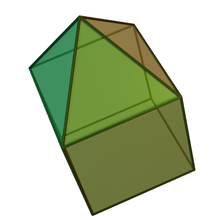In geometry, a composite polyhedron is a convex polyhedron that produces other polyhedrons when sliced by a plane. Examples can be found in Johnson solids.
Definition and examples
A convex polyhedron is said to be composite if there exists a plane through a cycle of its edges that is not a face. Slicing the polyhedron on this plane produces two polyhedra, having together the same faces as the original polyhedron along with two new faces on the plane of the slice. Repeated slicing of this type decomposes any polyhedron into non-composite or elementary polyhedra. Some examples of non-composite polyhedron are the prisms, antiprisms, and the other seventeen Johnson solids. Among the regular polyhedra, the regular octahedron and regular icosahedron are composite.

Any composite polyhedron can be constructed by attaching two or more non-composite polyhedra. Alternatively, it can be defined as a convex polyhedron that can separated into two or more non-composite polyhedra. Examples can be found in a polyhedron that is constructed by attaching the regular base of pyramids onto another polyhedron. This process is known as augmentation, although its general meaning is constructed by attaching pyramids, cupola, and rotundas. Some Johnson solids are examples of that construction, and they have other constructions as in elongation (a polyhedron constructed by attaching those onto the bases of a prism), and gyroelongation (a polyhedron constructed by attaching those onto the bases of an antiprism).
References
- ^ Timofeenko, A. V. (2009). "Convex Polyhedra with Parquet Faces" (PDF). Docklady Mathematics. 80 (2): 720–723. doi:10.1134/S1064562409050238.
- Hartshorne, Robin (2000). Geometry: Euclid and Beyond. Undergraduate Texts in Mathematics. Springer-Verlag. p. 464. ISBN 9780387986500.
- Johnson, Norman (1966). "Convex Solids with Regular Faces". Canadian Journal of Mathematics. 18: 169–200. doi:10.4153/CJM-1966-021-8.
- ^ Timofeenko, A. V. (2010). "Junction of Non-composite Polyhedra" (PDF). St. Petersburg Mathematical Journal. 21 (3): 483–512. doi:10.1090/S1061-0022-10-01105-2.
- Huybers, P. (2002). "The Morphology of Building Structures". In Sloot, Peter M.A.; Tan, C.J. Kenneth; Dongaraa, Jack J.; Hoekstra, Alfons G. (eds.). Computational Science — ICCS 2002: International Conference Amsterdam, The Netherlands, April 21–24, 2002 Proceedings, Part III. Lecture Notes in Computer Science. Vol. 2331. p. 89. doi:10.1007/3-540-47789-6. ISBN 978-3-540-43594-5.
- ^ Berman, Martin (1971). "Regular-faced convex polyhedra". Journal of the Franklin Institute. 291 (5): 329–352. doi:10.1016/0016-0032(71)90071-8. MR 0290245.
- Slobodan, Mišić; Obradović, Marija; Ðukanović, Gordana (2015). "Composite Concave Cupolae as Geometric and Architectural Forms" (PDF). Journal for Geometry and Graphics. 19 (1): 79–91.